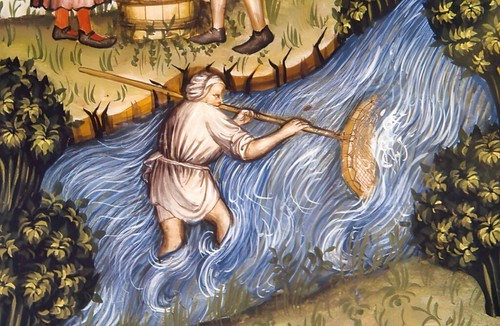
Mike Kodysz passed along this interesting article about how "eels essentially became currency" in medieval England. Thanks!
-Editor
 JOHN WYATT GREENLEE, A MEDIEVAL historian focusing on cartography, never intended to become the
JOHN WYATT GREENLEE, A MEDIEVAL historian focusing on cartography, never intended to become the Surprised Eel Historian, as he dubs himself on Twitter. When he first proposed his Ph.D. project on eels, it was declined. Greenlee went ahead and studied eels anyway, and his passion for these wormlike, elongated fish has now managed to capture the fascination of others. Greenlee specifically looks at the role eels played in medieval English economy and culture—a role far more important than many would think. In medieval England, eels essentially became currency. Medieval peasants would use the fish to pay their rent and make other economic transactions.
We have a really great and complicated history with eels, says Greenlee. Medieval land users were required to pay rent to the landowner each year, and in many cases, these rents were paid in kind. This means that they weren't paid in coins, but rather with goods, such as chickens, eggs, and—Greenlee's favorite—eels. The first recorded rent payment made with eels was in 700. By the time of the Domesday Book survey in 1086, a massive land survey conducted in England after William the Conqueror seized the island, we can see evidence for something more than half a million eels being paid in rent in England every year, says Greenlee.
When it comes to their numbers in comparison to other in kind rents, Greenlee emphasizes their popularity: There are more rents paid in eels than anything else in the Domesday survey. The question is: why? Paul Freedman, a medieval historian at Yale University, explains that eels were somewhere in between a delicacy and an everyday item. The fact that people were asked to pay rent in eels shows that their landlords wanted them. Most of the eel rents were paid in East Anglia, which is really great eel territory, says Freedman, because of the numerous marshes and low-lying areas with lots of water. Greenlee explains that a lot of mills end up paying rents in eels, probably because they catch a lot of eels near the mill races.
Monasteries and religious institutions also carried out a large number of eel transactions. In the Catholic world before the Reformation, there were lots of days in which you had to abstain from meat, particularly Lent before Easter. Meat markets shut down, and fish was the primary product, says Freedman. He notes that one reason for their popularity, apart from that they're very plentiful and could be [easily] gathered, was that the demand for fish was much greater than it is now because up to 120 days a year the consumption of meat was prohibited. Since eels were an appropriate Lent meal, monasteries saw them as a highly sought-after commodity and collected them in droves from their tenants. Some monasteries received tens of thousands of eels in rental transactions, stockpiling the eels to then pay for their needs.
These eel rent transactions are displayed in Greenlee's interactive map, which highlights rental payments made with eels throughout England from the 10th century up until the end of the 17th century. The transactions vary from single digits to the tens of thousands of eels. One enormous transaction shows that Ely Abbey, now known as Ely Cathedral, paid Thorney Abbey 26,275 eels to rent a fen (similar to a wetland), according to rare transaction records on parchment fragments held by the British Library.

Over time, the practice of paying rent with eels slowly declined. The reasons for this are unknown. Greenlee explains that some of it has to do with availability of money, some of it has to do with changes in habitat and ecology. In addition, the beginning of the Little Ice Age in the 14th century could have caused water bodies to become colder, leading to a reduction in eel populations. Kerr notes that measuring eel populations is incredibly difficult, and that even today eels are difficult to count, study, and understand: as with everything with eels, it's complicated.
To read the complete article, see:
To Pay Rent in Medieval England, Catch Some Eels
(https://www.atlasobscura.com/articles/medieval-eel-rent-map-england)
Wayne Homren, Editor
The Numismatic Bibliomania Society is a non-profit organization
promoting numismatic literature. See our web site at coinbooks.org.
To submit items for publication in The E-Sylum, write to the Editor
at this address: whomren@gmail.com
To subscribe go to: https://my.binhost.com/lists/listinfo/esylum
Copyright © 1998 - 2024 The Numismatic Bibliomania Society (NBS)
All Rights Reserved.
NBS Home Page
Contact the NBS webmaster
|




